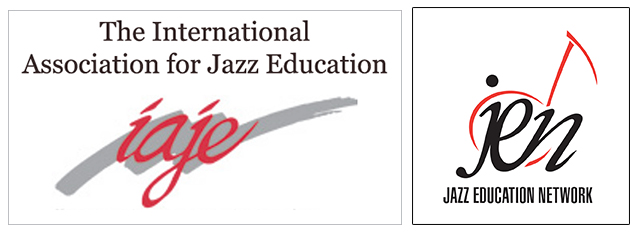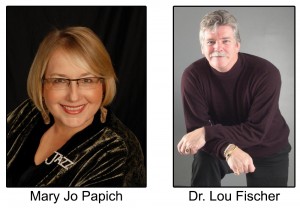In April 2008 the International Association for Jazz Education (a.k.a. the International Association of Jazz Educators) announced its intention to file for Chapter 7 Bankruptcy. Chapter 7 Bankruptcy meant liquidation of all assets and dissolution of the organization, as opposed to Chapter 11, protection from creditors.
The announcement as it appeared in JAZZed Magazine is as follows:
According to a letter from Chuck Owen, the President of IAJE on Friday, April 18, “the board voted to file for bankruptcy under Chapter 7 of the Federal Bankruptcy Law.” This leading music education association, which had over 8,000 members, an international convention, a bi-monthly journal, and a history of over 40 years has been crushed under a mountain of debt according to an article in theApril 18, 2008. The article indicated that the organization is rumored to have been over $1 million in debt. . . .It is difficult to pinpoint the exact reasons for this unprecedented downfall, but there were obviously festering financial difficulties which were not specifically addressed by either the paid management team or the elected board.
(http://www.jazzedmagazine.com/2326/articles/noteworthy/iaje-files-for-chapter-7-bankruptcy/)
Out of the ashes of IAJE’s downfall rose a new organization, the Jazz Education Network (JEN). This association–which just concluded its fifth annual conference in Dallas, Texas–was born primarily because of the herculean efforts of jazz educators Mary Jo Papich and Dr. Lou Fischer. Without their relentless efforts JEN would probably not exist.
And now it is five years later. In this context I asked JEN’s leadership—current President Andrew Surmani, President-Elect Bob Sinicrope, Immediate Past-President/Co-Founder/Conference Coordinator Dr. Lou Fischer, and Co-Founder Mary Jo Papich—to articulate a perspective on the association’s progress. I asked them to describe what JEN has accomplished in the last five years, what has not been accomplished, and their vision for the next five years.
Below are their collective responses agglomerated by Marina Terteryan, JEN’s Integrated Marketing Consultant:
JEN accomplishments
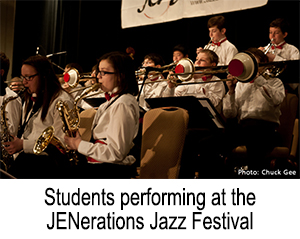 1. Five years of operating in the black financially
1. Five years of operating in the black financially
2. 1,500 members in all 50 USA States, 7 Canadian Provinces and 23 Countries
3. Four successful and profitable annual conferences (reaching over 9,000 attendees)
4. Site locations booked and contracts favorably negotiated for JEN through 2017
5. The JENerations Jazz Festival launched in 2012 and expanded in 2013
6. The Mentor Program launched and seven students formally mentored
7. The Outreach Program launched in 2010 (over 7,000 students served)
8. JAZZ2U launched in 2013 with the help of a generous donation from the Herb Alpert Foundation and more than $10,000 in grants awarded. An additional $15,000 grant has been awarded by the foundation to continue the program.
9. A generous donation by Jamey Aebersold in 2013 will be used to help improve our membership and registration process.
10. More than $28,000 in scholarship money awarded (over 50 total awards and scholarships)
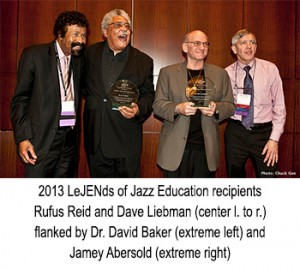 11. Student composition showcase launched in 2011 with 16 students honored.
11. Student composition showcase launched in 2011 with 16 students honored.
12. Four standing committees and 15 special committees formed and in operation
13. Over $25,000 of instruments and print music donated to schools in need through the JENerosity Project
14. Advancement of scholarly research, audience development research and technology initiated at our conference
15. Create a dedicated JEN section in each JAZZed magazine issue, which includes member resources and communications
16. Strategic Plan developed and launched on our website
17. Website launched, then redesigned, and to be re-launched again with a major new upgrade coming in January 2014
18. Strategic partnerships developed with Symphony Publishing/Timeless Communications, NAfME, IASJ, MFA, PASIC, MusicFest (Canada) and working on ACDA.
19. Hired three independent part-time contractors to work for the organization
What is yet to be accomplished?
• Our membership is growing steadily, but we would definitely like to expand our reach and attain more members and a larger conference attendance. We are aware that this can be due to a number of reasons, including economic reasons for potential members, and our reach. We are addressing this by making it a priority to do more proactive outreach to new communities and engage more with existing communities that we reach. To address economic reasons, JEN’s membership and conference prices are kept low. Click here to see membership levels.
• We’d like to get to a point where we can operate with a full staff. Currently, JEN is operated by volunteers and three part-time staff members. Though all staff and volunteers dedicate significant time, we would obviously gain more from expanding our team to be able to do more proactive membership drives and provide more resources to JEN members.
• We’d like the JEN website to be a source of all things jazz, including instructional resources, lists of jazz events, schools, etc. We have assembled a committee to help bring together all these elements. This is a big endeavor, so we are working to prioritize what our community could benefit from the most (and we are always open to ideas and requests).
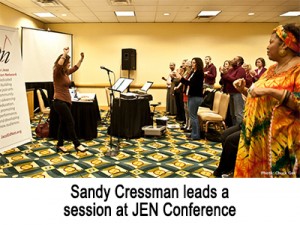 In addition to the Dallas, Texas conference recently concluded, JEN has committed to three more annual conferences: January 7–10, 2015, Manchester Grand Hyatt San Diego, CA; January 6–9, 2016, Galt House, Louisville, KY (same place where we had the 2009 conference), and January 4–7, 2017, Hyatt Regency, New Orleans, LA.
In addition to the Dallas, Texas conference recently concluded, JEN has committed to three more annual conferences: January 7–10, 2015, Manchester Grand Hyatt San Diego, CA; January 6–9, 2016, Galt House, Louisville, KY (same place where we had the 2009 conference), and January 4–7, 2017, Hyatt Regency, New Orleans, LA.
What Will Happen in 2018?
JEN is clearly a work in progress. The leadership is dedicated and has a vision of the future. It has managed to maintain itself (in the black apparently) through “The Great Recession”—no easy task when you’re struggling to get an organization off the ground. But the inevitable comparisons between the defunct IAJE and the nascent JEN are instructive.
The IAJE’s membership was approximately 8,000; JEN’s is currently 1,500. This issue is one JEN’s leadership is well aware of and one that can only improve over time. But membership numbers are a reflection of something more pressing.
The saying is “once bitten, twice shy.” The IAJE’s demise was primarily due to financial issues. How and why the organization became $1 million+ in the red is moot at this time. But I have a strong sense that JEN’s leadership will do anything not to fall into that pecuniary abyss. This is commendable.
While JEN’s vision of the future and its articulated Strategic Plan is on the right track, it must deal with a central issue going forward: the location of future conferences. This issue is directly related to membership numbers.
JEN traditionally holds its annual conferences in January, as did IAJE. IAJE’s conferences were held in Chicago, New York City, Anaheim (California), and Toronto. If you’ve never visited Toronto in January, you should try it just to get a sense of how cold, cold can be. Apparently the poor attendance at the Toronto conference was the financial straw that broke IAJE’s back!
JEN’s leadership has apparently made the decision to hold its annual January conferences in warm climes: Dallas, San Diego, Louisville, and New Orleans. New Orleans makes sense, of course, from a jazz history perspective. It is the geographic nexus of the birth of jazz. The other cities also make sense from a jazz education perspective. There are jazz educators, jazz  students, and jazz performers in those cities. But these cities do not reflect major centers of jazz in the United States. The major centers of jazz in the United States are New York City, Boston, Chicago, San Francisco, and Los Angeles.
students, and jazz performers in those cities. But these cities do not reflect major centers of jazz in the United States. The major centers of jazz in the United States are New York City, Boston, Chicago, San Francisco, and Los Angeles.
Yes, in January some of these cities can be cold, but this is where a large agglomeration of jazz educators, jazz students, and jazz performers reside. New York City, especially, can be considered a jazz world capital. It is also a global entertainment capital.
I can understand JEN leadership’s reluctance and trepidation to commit financially to a much larger stage for its annual conferences. In terms of money and organizational manpower, holding a conference in New York City is an order of magnitude much larger than Dallas, Texas. But it is an objective the leadership must deal with. Yes, there are jazz communities in the southern part of the United States and they need to be served, but there are larger jazz communities in the northern states that also need to be attended to. Perhaps for 2018 JEN will return to the colder canyons of New York City (or Boston or Chicago). I perceive JEN will get a warm reception and membership will grow.
Please write to me at meiienterprises@aol.com if you have any comments on this or any other of my blogs.
Eugene Marlow, Ph.D.
January 13, 2014
© Eugene Marlow 2014


